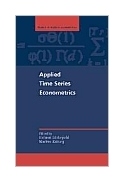|
||
• wydawnictwa polskie
• Zamów informacje o nowościach z wybranego tematu • kontakt
• Cookies na stronie |
APPLIED TIME SERIES ECONOMETRICSLUETKEPOHL H.wydawnictwo: CAMBRIDE , rok wydania 2004, wydanie Icena netto: Time series econometrics is a rapidly evolving field. Particularly, the cointegration revolution has had a substantial impact on applied analysis. Hence, no textbook has managed to cover the full range of methods in current use and explain how to proceed in applied domains. This gap in the literature motivates the present volume. The methods are sketched out, reminding the reader of the ideas underlying them and giving sufficient background for empirical work. The treatment can also be used as a textbook for a course on applied time series econometrics. Topics include: unit root and cointegration analysis, structural vector autoregressions, conditional heteroskedasticity and nonlinear and nonparametric time series models. Crucial to empirical work is the software that is available for analysis. New methodology is typically only gradually incorporated into existing software packages. Therefore a flexible Java interface has been created, allowing readers to replicate the applications and conduct their own analyses. Table of Contents1. Initial tasks and overview: 1.1 Introduction; 1.2 Setting up an econometric project; 1.3 Getting data; 1.4 Data handling; 1.5 Outline of chapters; 2. Univariate time series analysis: 2.1 Characteristics of time series; 2.2 Stationary and integrated stochastic processes; 2.3 Some popular time series models; 2.4 Parameter estimation; 2.5 Model specification; 2.6 Model checking; 2.7 Unit root tests; 2.8 Forecasting univariate time series; 2.9 Examples; 2.10 Where to go from here?; 3. Vector autoregressive and vector error correction models: 3.1 Introduction; 3.2 VARs and VECMs; 3.3 Estimation; 3.4 Model specification; 3.5 Model checking; 3.6 Forecasting VAR processes and VECMs; 3.7 Granger-causality analysis; 3.8 An example; 3.9 Extensions; 4. Structural vector autoregressive modelling and impulse responses: 4.1 Introduction; 4.2 The models; 4.3 Impulse response analysis; 4.4 Estimation of structural parameters; 4.5 Statistical inference for impulse responses; 4.6 Forecast error variance decomposition; 4.7 Examples; 4.8 Conclusions; 5. Conditional heteroskedasticity: 5.1 Stylized facts of empirical price processes; 5.2 Univariate GARCH models; 5.3 Multivariate GARCH models; 6. Smooth transition regression modelling: 6.1 Introduction; 6.2 The model; 6.3 The modelling cycle; 6.4 Two empirical examples; 6.5 Final remarks; 7. Nonparametric time series modelling: 7.1 Introduction; 7.2 Local linear estimation; 7.3 Bandwidth and lag selection; 7.4 Diagnostics; 7.5 Modelling the conditional volatility; 7.6 Local linear seasonal modelling; 7.7 Example I: average weekly working hours in the U.S.; 7.8 Example II: XETRA dax index; 8. The software JMulTi: 8.1 Introduction to JMulTi 8.2 Numbers, dates and variables in JMulTi 8.3 Handling datasets; 8.4 Selecting, transforming and creating time series; 8.5 Managing variables in JMulTi; 8.6 Notes for econometric software developers; 8.7 Conclusion. 322 pages Księgarnia nie działa. Nie odpowiadamy na pytania i nie realizujemy zamówien. Do odwolania !. |


